If you've been on the road at all in the last couple of years, you've probably seen Cellucor C4 Energy Drink in every gas station on the interstate. Over the past four years, the C4 cans became a fast as a competitor in the performance-boosting segment of the supplement market, and their product designs are almost always a reflection of this. But before those cans were everywhere, we had the sports supplements from Cellucor - and that meant a huge series of C4 pre-workout supplements.
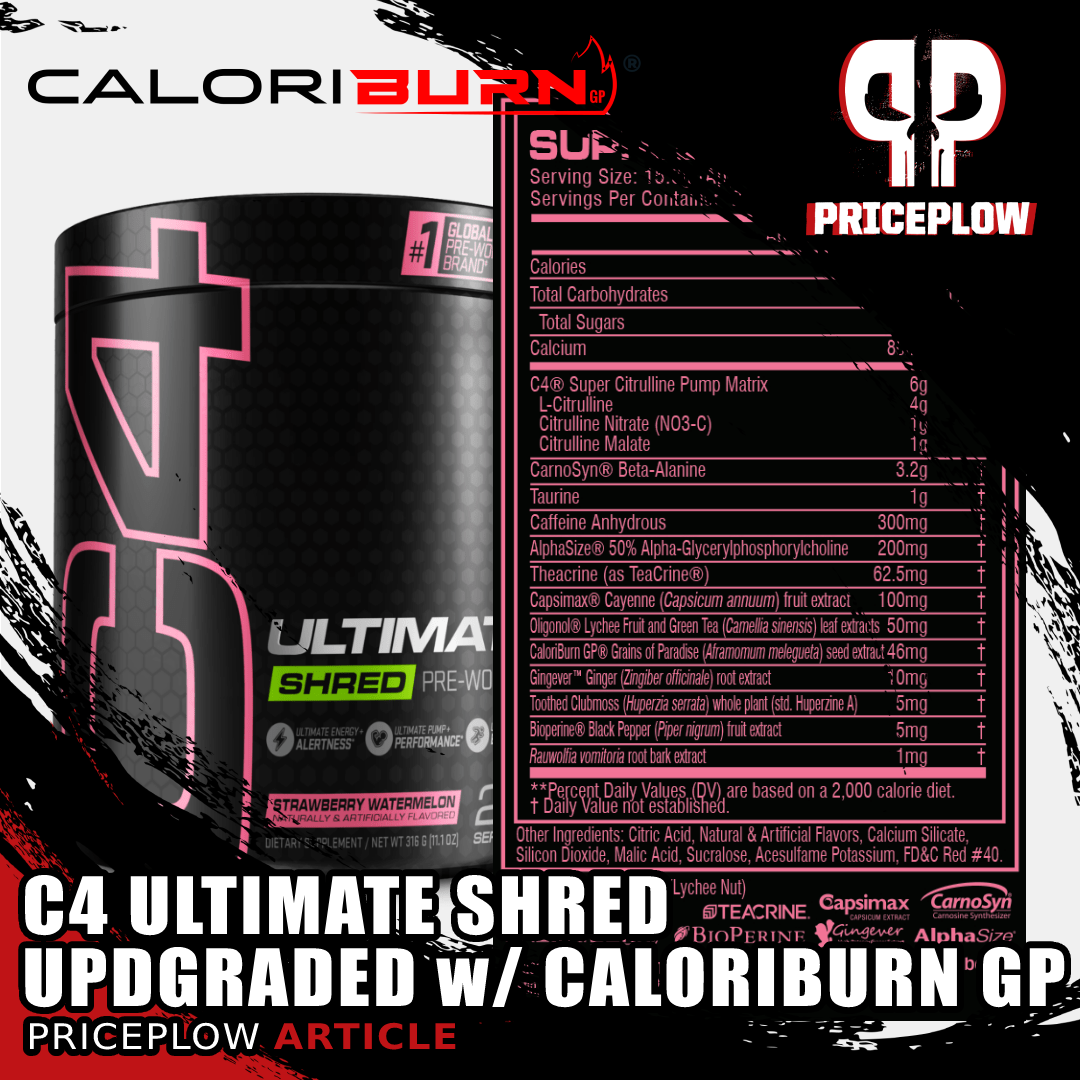
Cellucor C4 Ultimate Shred has been updated with a very unique 46mg dose of CaloriBurn GP from NNB Nutrition, bringing more thermogenesis and heat than ever before!
Today we've got some great news from from Cellucor: C4 Ultimate Shred, a fat-burning pre-workout formula, has some strong updates.
The combination of these two categories is something we love to see. After all, most people who are trying to lose weight exercise regularly, so a product like this kills two birds with one stone.
C4 Ultimate Shred Upgraded with CaloriBurn GP
This isn't a new product, but we're especially excited to see the CaloriBurn GP grains of paradise extract from NNB Nutrition added to the fully-disclosed profile. CaloriBurn works by driving mitochondrial biogenesis, an incredibly important process that we harp on all the time here at the PricePlow blog.
On top of 300 milligrams of caffeine and a 6 gram citrulline matrix in each scoop, CaloriBurn works to accelerate weight loss by short-circuiting the electron transport chain in cells, causing your body to burn energy off as heat. And speaking of heat, there's also capsaicin and black pepper extract to boot - this is no slouch!
We'll get into it, but first, check the PricePlow's prices and sign up for news and deals:
Cellucor C4 Ultimate Shred – Deals and Price Drop Alerts
Get Price Alerts
No spam, no scams.
Disclosure: PricePlow relies on pricing from stores with which we have a business relationship. We work hard to keep pricing current, but you may find a better offer.
Posts are sponsored in part by the retailers and/or brands listed on this page.
Note: In the listings above, be sure to find the new tubs launched in October 2022 with CaloriBurn GP on the label!
This area is reserved for Team PricePlow's upcoming Ingredients video.
Subscribe to our channel and sign up for notifications so you catch it when it goes live!
Ingredients
In a single 1-scoop (15.8 gram) serving of C4 Ultimate Shred from Cellucor, you get the following:
-
C4 Super Citrulline Pump Matrix – 6,000 mg
First up we have multiple forms of citrulline to help you achieve an awesome pump.
-
L-Citrulline – 4,000 mg
Most of the citrulline here comes in the form of L-citrulline, or pure citrulline. We'll discuss this first, not only because it's the most abundant form of citrulline in the formula, but also because our discussion will establish the benefits that are common to all forms of citrulline.
We see citrulline used all the time in pre-workout supplements because of its ability to increase nitric oxide (NO) production.[1] It's currently the supplement industry's mainstay NO-boosting ingredient because it's incredibly effective, cheap, and safe.
Citrulline is an amino acid, and amino acids are divided into three categories:
- Non-essential
- Conditionally essential
- Essential
Non-essential means there's no dietary requirement for the amino acid because your body can produce the amino on its own. However, generally speaking, we still need to give our bodies the necessary precursors for non-essential amino acid synthesis.
Essential amino acids are those your body cannot make on its own. These amino acids need to be consumed in their whole form from food.
Conditionally essential aminos are in between: your body can make some, but not always enough to cover its metabolic requirements. For example, when your body is healthy, well-fed and rested, it might be able to create more of a conditionally essential amino acid that you actually need. But in times of illness, injury, or stress — all of which increase your body's metabolic requirements — your body may not be able to keep up with the demands for conditionally essential aminos.
Citrulline belongs to the conditionally essential category. It's a crucial part of your body's NO cycle that may not always be available in sufficient quantities to help your body deal with metabolic stress.
Citrulline's participation in the nitric oxide cycle and the urea cycle. The enzyme argininosuccinate converts citrulline to arginine, and arginine stimulates the production of nitric oxide[2]
Between citrulline and NO, there's actually an intermediary step: the conversion of citrulline to arginine, the direct NO precursor, by the enzyme argininosuccinate (sometimes spelled arginosuccinate).
Arginine then gets converted into NO.
Why we want more NO: vasodilation
The reason to use a NO booster is that NO triggers vasodilation, a process by which your blood vessels expand in diameter, permitting more blood flow and better circulation. When vasodilation occurs, blood perfusion increases while heart rate and blood pressure drop, meaning your heart doesn't have to work as hard.[3-5]
As a result of all this, oxygen and nutrients get delivered to your cells more efficiently, while waste gets removed more efficiently. This can lead to increased athletic performance and faster recovery.
Endurance particularly benefits from vasodilation through the upregulation of NO.
The evidence on citrulline indicates the following benefits from citrulline supplementation:
- More power through better oxygen uptake[6]
- Greater athletic endurance – by up to 50%[7]
- Decreased muscle soreness from exercise[7]
- Increased growth hormone production from workouts[8]
- Decreased protein catabolism[9]
- Increased muscle protein synthesis[10,11]
Citrulline's effect on recovery: improved ammonia clearance
One reason why citrulline is a particularly good choice of NO booster is that in addition to the performance and recovery benefits from NO upregulation, citrulline can help your body clear ammonia, a toxic metabolic waste product.
It does this by increasing your body's supply of ornithine,[12] an amino acid that removes ammonia from the body.[13] Ammonia is a major contributor to fatigue, both physical and mental.[14,15] Thus, anything that helps remove ornithine can help decrease fatigue.
Ornithine can also indirectly improve fatigue by improving sleep quality and decreasing perceived stress. Ornithine seems to do this, in part, by reducing cortisol and increasing dehydroepiandrosterone (DHEA), a steroid hormone that declines sharply as we age and is associated with many aspects of youthfulness.[13]
Generally speaking, the dose of citrulline that's studied and used in nutritional supplements is about 3,000 milligrams. Here, we have twice that, which is great because the effects of citrulline on NO production have been shown to be dose-dependent.[16] In fact, returns on additional citrulline intake don't start to diminish until somewhere around the 10,000-milligram mark.[17]
Twice the dose doesn't necessarily mean twice the effect, but you can get a bigger effect from taking more.
**The reason you supplement with citrulline instead of arginine is that citrulline is orally bioavailable, whereas arginine is not.[18,19]
-
Citrulline Nitrate (NO3-C) – 1,000 mg
Next in the citrulline blend we have citrulline nitrate.
Nitrates are another precursor to NO. When we consume nitrates, the process of converting them into NO begins with the salivary glands in our mouth.[20-22]
Thus, consuming nitrates can also trigger vasodilation,[23] and confer all the usual benefits associated with it, like increased performance[24,25] and faster recovery.[25,26]
In 2013, the International Journal of Sport Nutrition and Exercise Metabolism published a meta-analysis[27] that found nitrate supplementation can improve circulation,[28] aerobic efficiency,[28,29] strength,[30,31] recovery speed, and cellular energy production.[31-33]
In other words, the research in nitrates looks a lot like the research on citrulline. This isn't surprising, since they act by the same mechanism – increasing NO production.
The idea behind including citrulline nitrate is to hit NO production from multiple angles.
-
Citrulline Malate – 1,000 mg
Next up is citrulline malate, which is citrulline bound to malic acid.
You can probably tell that we love citrulline, but the malate part of this one is pretty awesome too. Malic acid is centrally implicated in the Krebs cycle, one of the most important processes for cellular energy production.[34]
Some studies have found that citrulline malate can improve your body's aerobic respiration, making more energy available throughout your workout.[35]
-
-
CarnoSyn Beta-Alanine – 3,200 mg
Main purpose: boosting endurance
When beta-alanine combines with histidine, an essential amino acid, together they form carnosine.[34]
Carnosine helps your body flush lactic acid out of the muscles. Beta alanine helps you get more muscle carnosine content.
We like carnosine because it helps remove lactic acid from muscle tissue, which improves performance and recovery. Endurance, in particular, benefits from improved lactic acid clearance.
The ability of beta-alanine to improve endurance through upregulating carnosine is well known to researchers. Two large meta-analyses, one from 2012[35] and the other from 2016,[36] found that beta-alanine can measurably boost endurance for exercises of a particular intensity level. That intensity seems to be what an individual can sustain for anywhere from 30 seconds to 10 minutes, without stopping.[36]
Beta-alanine tingles
Pretty much everybody, upon taking beta-alanine, gets the beta-alanine tingles. These are pretty self-explanatory: a tingling sensation in your upper body and face. Don't worry about this if it happens to you because there's no evidence it's harmful. A 2019 safety study of beta-alanine states that the compound "does not adversely affect those consuming it."[37]
-
Taurine – 1,000 mg
Taurine is a conditionally essential amino acid and awesome all-around performance booster that we think is currently underrated in the supplement industry.
Taurine does so many different things that assigning it to a category is difficult. But the first thing you should probably know about taurine, in the context of a pre-workout formula, is that it's an osmolyte.
Osmolytes are good for performance because they improve your cells hydration status by increasing osmotic pressure around cells to the point where more water than usual is forced into them.[38] This is called a state of hyperhydration, and it comes with some interesting benefits for health and performance.
Hyperhydration, by supplying cells with more nutrients and helping cool them faster, can potentially empower your cells to work harder for longer. This can delay the onset of whole-body fatigue, thus boosting both aerobic and anaerobic endurance.
A large meta-analysis found that a single dose of taurine before a workout can significantly improve endurance while exercising.[39] According to this meta-analysis, 1,000 milligrams is an adequate dose for endurance boosting, so we're glad to see that dose used in C4 Ultimate Shred from Cellucor.
Taurine is also a powerful antioxidant[40,41] and helps support calcium signaling in muscle cells,[42] which is important for maximal muscular contractions.
The best nutritional supplements have some kind of paradoxical effect, and taurine definitely falls into this category. Although taurine can increase calcium activity in skeletal muscle, in the central nervous system it actually inhibits calcium signaling, which is a generally good thing as it means taurine can help prevent glutamate-mediated excitotoxicity.[43]
Taurine's impact on calcium signaling is part of its GABAergic activity in the brain, where it helps dampen the fires of inflammation while facilitating inter-neuronal communication and driving mitochondrial biogenesis in neurons.[44]
Taurine supplementation has been shown to improve certain aspects of learning, particularly motor learning,[45] and protects against brain damage in cases of metabolic syndrome or type 2 diabetes.[46] This suggests that taurine is broadly dopaminergic and neuroprotective. Taurine has also been shown in animal models to improve symptoms of crippling neurodegenerative illnesses like Parkinson's disease.[47]
Taurine supplementation is of particular benefit for anyone who's working hard – mentally or physically – as its conditionally essential status[38,39,44] means it will be depleted by increased metabolic requirements.
-
Caffeine Anhydrous – 300 mg
Caffeine is a nutritional supplement that almost needs no introduction. It's the most widely used (legal) drug in the world, capable of penetrating the brain blood barrier and exerting a range of anti-fatigue, pro-vigilance effects on the central nervous system.[48] Caffeine does this primarily by inhibiting adenosine, a nucleotide that produces fatigue as it builds up in neural tissue.[49]
Almost all of us are familiar with this aspect of caffeine from direct experience. Fewer of us realize that caffeine can bestow some major cellular-metabolic benefits as well.
Caffeine has a huge impact on cellular energy production through by inhibiting phosphodiesterase, an enzyme whose job is to break down cyclic adenosine monophosphate (cAMP),[50,51] a messenger molecule that tells cells to burn glucose and fatty acids for energy (in the form of adenosine triphosphate, or ATP).[50,51] cAMP is a major factor in overall metabolic rate. The more cAMP you have, the faster you'll burn calories.[52]
In particular, caffeine is great at increasing your body's rate of fat burning. Caffeine has been shown to increase fat burning by as much as 50%,[53] which is why it often shows up in fat burner formulas as well as pre-workouts.
Your energy needs cellular energy to do work, just like a car needs gas to drive. In light of that, it's not hugely surprising that inhibiting phosphodiesterase through caffeine use has been shown to significantly improve certain aspects of both mental and physical performance.
The performance-boosting effects of caffeine have earned it the status of ergogenic aid, according to official positions taken by international sporting organizations.[49,54] Athletes who take caffeine are stronger, faster, and longer-lasting, so long as the effects of the stimulant remain active.[55]
When it comes to mental performance, caffeine can decrease reaction time,[56] make you more attentive,[56,57] and increase working memory.[58] Mental energy and motivation go hand-in-hand, which is one reason why we love to see caffeine dosed appropriately in pre-workout formulas. It can really help you get in the gym and work hard.
Regarding the dose, beware – 300 milligrams is significant. Habitual caffeine users (most of us) may not have an issue with taking this much at once, but people who use caffeine infrequently or irregularly should exercise caution.
If you're not sure of your caffeine tolerance, start with a smaller dose and work your way up.
-
AlphaSize 50% Alpha-Glycerylphosphorylcholine – 200 mg
Alpha-Glycerylphosphorylcholine, abbreviated (mercifully) as alpha GPC, is a special form of the essential B vitamin, choline.
Choline is an important building block for cellular phospholipid bilayer membranes, the fatty envelopes that enclose the contents of all your body's cells. These not only help your cell retain its organelles and nutrients, but also keep unwanted substances (i.e. pathogens and metabolic waste products) out.[59]
Choline is also important as a precursor to acetylcholine, a neurotransmitter that's key for learning and the process of memory consolidation because of its ability to support inter-neuronal communication.[60] The more choline your body has, the more acetylcholine it can produce, which ultimately can lead to improvements in many different aspects of cognition. Memory, learning, attention, alertness, and even motor skills — like balance and coordination — can benefit from choline supplementation.[61,62]
Alpha GPC is one of the best forms of choline, because of its high bioavailability and unique ability to cross the brain-blood barrier.[63]
-
Theacrine (as TeaCrine) – 62.5 mg
Theacrine is a purine alkaloid, similar in composition and function to caffeine.[64] It was first discovered in a particular strain of tea called kucha tea, known scientifically as Camellia assamica var. kucha.[65]
Much like caffeine, it's capable of increasing both mental and physical energy,[66] partly because it blocks the action of adenosine just like caffeine does.[67]
Theacrine is similar to caffeine, but definitely not the same, providing a possibly far longer lasting effect.
Theacrine also inhibits phosphodiesterase,[68] which means we would expect theacrine to have the same cAMP-mediated benefits for cellular metabolism that we discussed in the caffeine section.
Another similarity between theacrine and caffeine is the fact they're both dopaminergic,[64] which can help with motivation and focus.
Theacrine seems to have potent antidepressant effects, and has been shown to promote hippocampal neurogenesis in mouse models.[65] That suggests a powerful effect on neurological health, since hippocampal neurogenesis is significantly decreased by depressive disorders,[69] and increasing it can help alleviate symptoms.[70]
-
Capsimax Cayenne (Capsicum annuum) fruit extract – 100 mg
Cayenne pepper extracts are generally standardized for capsaicin, the main bioactive constituent in peppers.
Capsaicin has been used in the supplement industry for decades because of its fat burning, thermogenic effects.[71] It also has an appetite-suppressing effect, which can make weight loss easier – especially if you're working out hard on a cut.[72] This really makes it the perfect ingredient for a fat-burning pre-workout formula like Cellucor C4 Ultimate Shred.
One study found that daily supplementation with merely 6 milligrams of capsaicin over a 12 week period was enough to significantly reduce body fat.[73]
Capsaicin may also help you push yourself harder in the gym: through its modulation of pain receptors, it can make people less sensitive to pain, effectively increasing pain tolerance.[74]
One thing to note about capsaicin, though, is that it can raise blood pressure and heart rate in susceptible individuals.[71] So if you've never taken capsaicin before, keep an eye on yourself while using it, and talk to your doctor if you aren't sure whether capsaicin is right for you.
-
Oligonol Lychee Fruit and Green Tea (Camellia sinensis) leaf extracts – 50 mg
Oligonol is a patented blend of polyphenol extracts, derived from lychee fruit and green tea.
The first thing to know about polyphenols in the context of any fat burning supplement is that research consistently finds overall polyphenol intake to inversely correlate with risk for type 2 diabetes,[75] partly because polyphenols improve insulin sensitivity.[76]
One study in elderly subjects found that the more polyphenols participants consumed, the lower their risk of obesity was.[77] Their polyphenol blood levels inversely correlated with body weight, meaning the more polyphenols they consumed, the less they weighed.[77]
Epigallocatechin gallate (EGCG), the primary antioxidant in green tea, is particularly good at improving metabolic health and burning fat,[78] which is why we have it here from the green tea portion of oligonol.
Oligonol is the name of a specific polyphenol that comes from lychee fruit, and has similar effects as the green tea polyphenols, and other polyphenols in general: it improves insulin sensitivity, specifically by suppressing the accumulation of fat in liver tissue.[79]
Defatting the liver is a big deal because fatty liver (known technically as non-alcoholic fatty liver disease, or NAFLD) is closely associated with insulin resistance and diabetes. Although the science is not yet settled, some researchers believe that NAFLD might even cause insulin resistance and diabetes.[80]
-
CaloriBurn GP Grains of Paradise (Aframomum melegueta) seed extract – 46 mg
CaloriBurn GP is a patented extract of the grains of paradise pepper plant, known officially as Aframomum melegueta. It was developed and trademarked by NNB Nutrition, a premier novel dietary supplement ingredient developer.
NNB Nutrition's CaloriBurn has 12.5% 6-Paradol, but uses pure grains of paradise to keep all of the active constituents. This is the major change in C4 Ultimate Shred
The NNB extraction process is standardized to yield 12.5% 6-paradol by weight. We like 6-paradol because it beneficially alters the fat composition of the human body, and is what was used in studies that will be cited below. However, as we'll discuss later, there's more than just that in CaloriBurn.
Put simply, we have two types of adipose (fat) tissue: white adipose tissue (WAT) and brown adipose tissue (BAT). These two types of tissue serve very different functions. WAT is used for long-term energy storage, and is generally only metabolized for fuel when calorie intake is catastrophically low, i.e. in famine conditions.[81]
BAT, on the other hand, is the site where a process called non-shivering thermogenesis takes place. In non-shivering thermogenesis, your body burns calories for heat. The original purpose behind this mechanism was to help maintain your body temperature in the face of cold exposure.[81]
Regardless of why your body is burning calories, more calories burned equals faster weight loss: the more BAT you have, the faster your metabolism, and the faster you'll lose weight.[82,83] And the great thing about BAT is that it doesn't just use fat for fuel. BAT can also use glucose as a substrate for non-shivering thermogenesis.[84] This translates into improved blood glucose metabolism, and better overall metabolic health, even in the absence of weight loss.[84]
So with all this context in mind, you can understand the significance of 6-paradol causing WAT to be converted to BAT.[85]
In one study, 19 healthy men between the ages of 20 and 32 took 40 milligrams of grains of paradise extract daily while researchers measured their energy expenditure.
The study authors found that compared to a placebo control group, the men taking grains of paradise had a higher metabolic rate due to increased BAT activity.[85]
Another study found that women who took grains of paradise had lower levels of visceral fat by the end of the study period.[86] This is great because visceral fat is a particularly harmful type of fat, closely associated with insulin resistance and diabetes.[87]
The harmful effects of visceral fat were shown in an animal study where the surgical removal of this type of fat – while leaving other fat deposits untouched – prevented age-related metabolic decline in rats.[88]
So anything that targets visceral fat can be a boon for metabolic health.
CaloriBurn is not just HPLC tested, but HLPTC, so you know it's real GP, bringing with it more than just 6-paradol, but the three other major constituents (6-gingerol, 6-shogaol, and 6-gingerdione) with it as well!
Why CaloriBurn is so awesome part 1: all four constituents
CaloriBurn is an awesome ingredient for multiple purposes. First, realize that it's not just 6-paradol (which is what was used in the two human studies above). It also contains the three other important constituents: 6-gingerol, 6-gingerdione, and 6-shogaol. These may provide additional benefits -- all four parts may support TRPV1 activation,[89,90] which is one of the mechanisms that may also make capsaicin work well.
Why CaloriBurn is so awesome part 2: mitochondrial biogenesis
Further, to understand what else makes CaloriBurn so good, we need to talk a little bit about the specific difference between BAT and WAT.
Compared to WAT, BAT is rich in mitochondria,[91] and, in fact, the high mitochondrial density of BAT is where it gets its name brown adipose tissue. When light passes through an adipose tissue sample under a microscope, mitochondria absorb most of it, creating a dark brown spot wherever a mitochondrion happens. With high mitochondrial density, the entire adipose slice appears brown compared to WAT, which is comparatively devoid of mitochondria.
So converting WAT to BAT, as CaloriBurn does, involves driving the creation of new mitochondria inside WAT. The proliferation of these mitochondria is what turns white adipose tissue brown.
One study explains how these mitochondria burn off extra energy:
"Brown adipose tissue (BAT) mitochondria are distinct from their counterparts in other tissues in that ATP production is not their primary physiologic role. BAT mitochondria are equipped with a specialized protein known as uncoupling protein 1 (UCP1). UCP1 short–circuits the electron transport chain, allowing mitochondrial membrane potential to be transduced to heat, making BAT a tissue capable of altering energy expenditure and fuel metabolism in mammals without increasing physical activity."[92]
In other words, the name uncoupling protein 1 comes from the fact that UCP1 works to uncouple mitochondrial activity from metabolic requirements. Under the conditions of high UCP1 expression, your body torches calories regardless of what physical demands are occurring.
And more BAT mitochondria translates to greater UCP1 activity. If you're following the analysis quoted above, it probably won't surprise you to learn that UCP1 upregulation is protective against obesity[93] and increases insulin sensitivity, which is absolutely crucial for good metabolic health.
We harp on mitochondria all the time here at the PricePlow Blog, and regular readers are probably starting to see why: all the best ingredients seem to work by directly stimulating mitochondrial biogenesis and function.
Any ingredient that significantly improves mitochondrial number or function should be given close attention and consideration.
To learn more about grains of paradise, read our two articles titled Grains of Paradise: Fat Fighting Spice of the Goddesses and CaloriBurn: NNB Takes Grains of Paradise to Hot New Heights.
Interesting is this dose - 46 milligrams per scoop. 40 milligrams per day is the clinical daily dose that satisfies both human studies described above, but Cellucor went above and beyond with over 10% more... for the perfect amount of shredding spice.
-
Gingever Ginger (Zingiber officinale) root extract – 10 mg
The first thing to know about ginger extract is that it contains high amounts of 6-paradol, a compound we just discussed pretty extensively in the previous section.[94] Thus, from a good ginger extract we can expect some good WAT to BAT conversion.
Ginger boasts three main phenols - gingerol, shogaol, and zingerone - with gingerol getting much of the attention.
And in fact, the evidence on ginger indicates that this is the case. Studies have observed WAT to BAT conversion in animals taking ginger.[95] This is not due just to 6-paradol, but also to 6-gingerol[96] and other related bioactive constituents in ginger. This is like taking our CaloriBurn GP and amplifying its effects even more!
A meta-analysis of randomized controlled trials on ginger intake found that ginger consumption improves body composition, waist-to-hip ratio, heart rate, fasting glucose, and HOMA-
IR scores (a measure of insulin resistance). Ginger can also increase HDL-cholesterol levels —the good kind of cholesterol.[97]
These positive effects of ginger can be put down to its gingerols and shogaols, which have anti-inflammatory and antioxidant properties.[98,99]
-
Toothed Clubmoss (Huperzia serrata) whole plant (std. Huperzine A) – 5 mg
Huperzine A is a sesquiterpene alkaloid that is often included with acetylcholine precursors, like the alpha-GPC ingredient we discussed earlier.
While alpha-GPC increases your body's production of acetylcholine, huperzine A makes your body break it down more slowly, by inhibiting the enzyme acetylcholinesterase.[100] So with a combination of these two ingredients, you're attacking the acetylcholine problem from both angles.
Huperzine A is good enough at boosting acetylcholine levels through acetylcholinesterase inhibition that it's often taken on its own as a nootropic supplement.[101]
It's also good at defending the mitochondria in your brain cells from oxidative stress, which probably contributes to its nootropic effect.[102]
-
BioPerine – 5 mg
BioPerine is a black pepper extract that functions as a bioavailability enhancer, by increasing your body's absorption of whatever it's stacked with. In other words, BioPerine makes every other ingredient in Cellucor C4 Ultimate Shred more effective.
Black pepper extract is especially fun when combined with grains of paradise below. Image courtesy Wikimedia.
Piperine, a powerful antioxidant,[103] is the bioactive constituent responsible for BioPerine's bioavailability-enhancing properties.[104] It works by inhibiting stomach enzymes that ordinarily degrade nutrients before they can be absorbed through the intestinal wall.
Piperine has some cool metabolic benefits as well. It upregulates glucose transporter 4 (GLUT4), which improves your body's metabolism of glucose and helps keep blood glucose levels under control.
It also improves insulin sensitivity while defatting the liver.[105]
-
Rauwolfia vomitoria root bark extract – 1 mg
Extracts of Rauwolfia vomitoria, known colloquially as the poison devil's-pepper, are standardized for an alkaloid called rauwolscine.
Rauwolscine is often referred to as alpha yohimbine, because it's similar in its effects to yohimbine, but far stronger. However, one interesting thing to note about Rauwolfia vomitoria extracts is that they usually contain some yohimbine in addition to rauwolscine.
Both rauwolscine and yohimbine are alpha-2 antagonists, which can help shift your body into fight-or-flight mode by activating adrenaline and noradrenaline receptors.
These alkaloids can suppress appetite,[106] accelerate fat loss,[107] and enhance focus.[108] Rauwolscine, in particular, has been shown to prevent the body from storing fat, while increasing its cellular energy supply.[109]
Note that rauwolscine and yohimbine are stimulants, meaning that tolerance will vary from person to person. Use caution if you've never taken rauwolscine or yohimbine before.
Flavors Available
Conclusion: 46mg CaloriBurn Brings C4 Ultimate Shred Home!
C4 Ultimate Shred is billed as a fat-burning pre-workout, but there's actually even more to it than that. The acetylcholine double-whammy from huperzine A and alpha-GPC can also get your brain clipping along like a fine Swiss watch.
More and more manufacturers are putting some kind of nootropic into pre-workout formulas, because of the growing realization that mental energy and focus are just as important for a good workout as physical energy.
We also love seeing the CaloriBurn GP grains of paradise extract from NNB Nutrition because preventing energy overload is crucial for staying lean and healthy. But what we love even more is the epic 46 milligram dose -- why stop at 40?! In our opinion, ingredients that drive mitochondrial health and biogenesis are worth their weight in gold, especially in this toxic food environment we live in.
To design a do-it-all formula like this, ingredients have to be chosen for maximum effect, and we believe Cellucor succeeded with C4 Ultimate Shred.
Cellucor C4 Ultimate Shred – Deals and Price Drop Alerts
Get Price Alerts
No spam, no scams.
Disclosure: PricePlow relies on pricing from stores with which we have a business relationship. We work hard to keep pricing current, but you may find a better offer.
Posts are sponsored in part by the retailers and/or brands listed on this page.
Note: In the listings above, be sure to find the new tubs launched in October 2022 with CaloriBurn GP on the label!
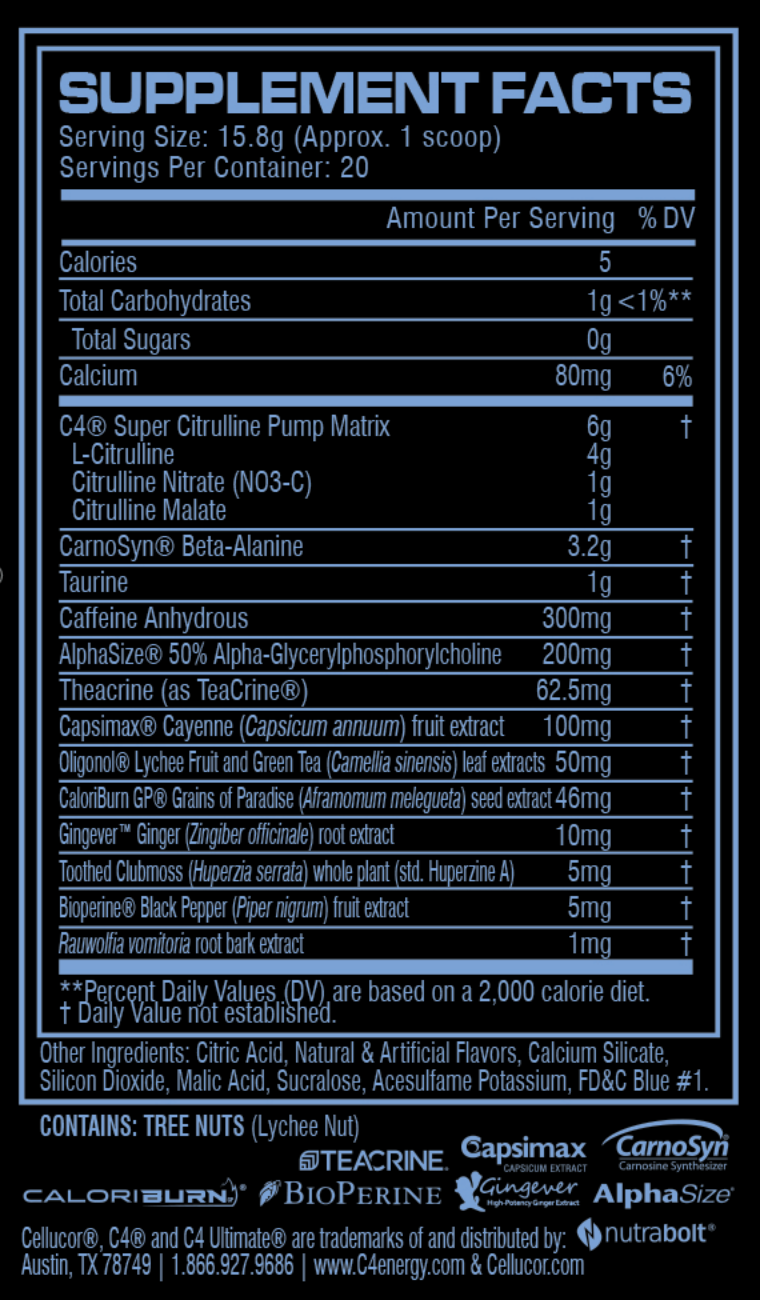

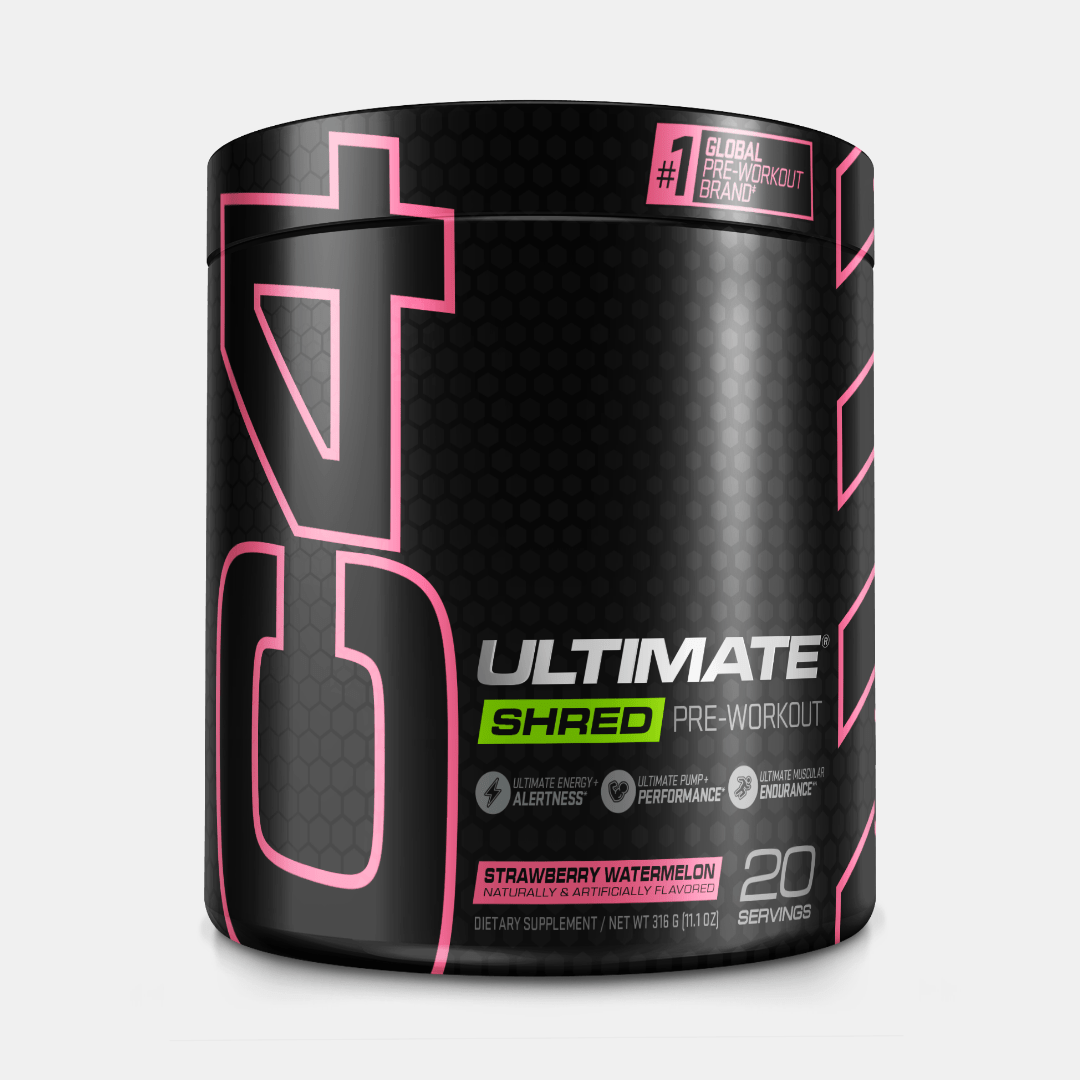
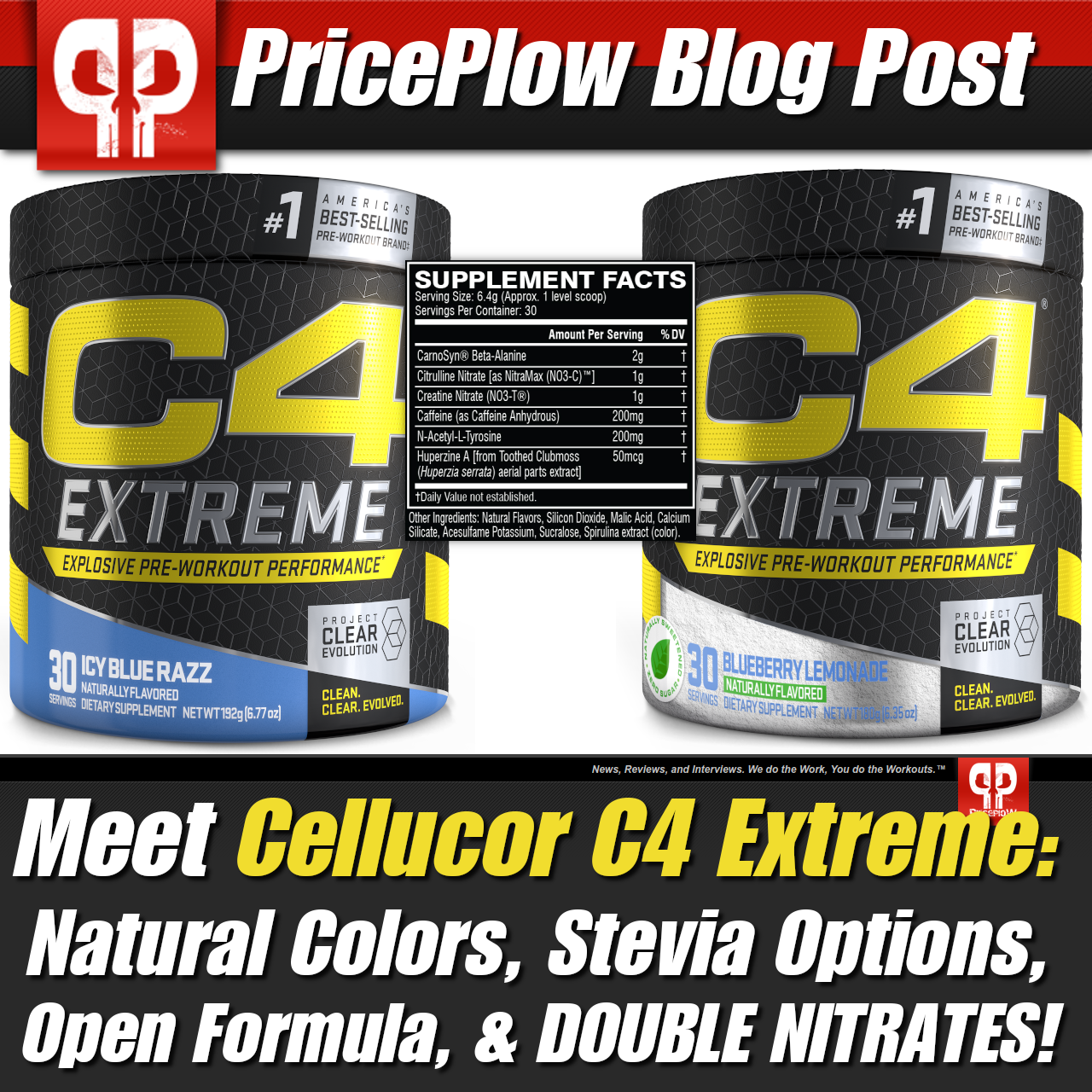
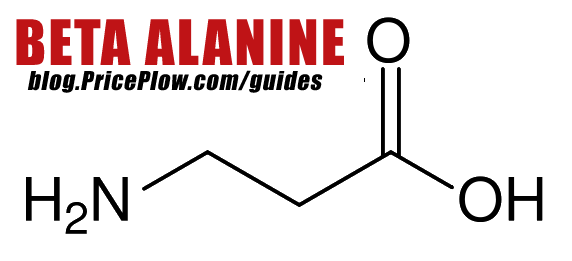










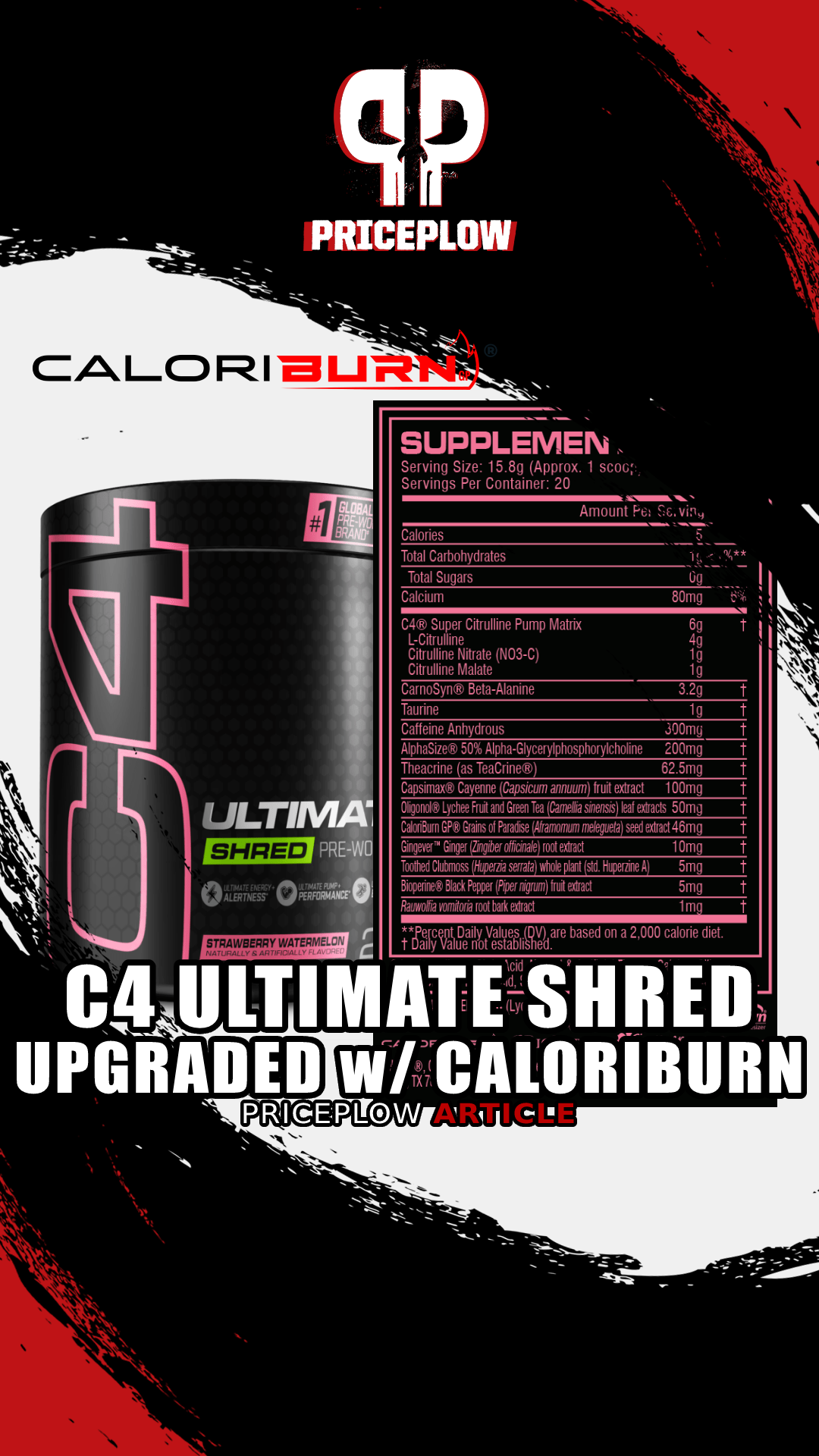


Comments and Discussion (Powered by the PricePlow Forum)